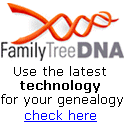
Latvian Genetics: Abstracts and Summaries
by Kevin Alan Brook

Family Tree DNA: Genetic Testing Service
Genetic testing enables you to compare your genes with other families and
ethnic groups. The database includes not only Latvians but also
Lithuanians, Russians, Estonians, Finns, and most other peoples of
Europe. If you're a Latvian in your maternal or paternal lineages, you'll
become eligible to join the "My FamilyTree DNA Latvia Project".
|
Latvia is a small country in northeastern Europe sandwiched between
Lithuania to the south and Estonia to the north, with Russia to the east
and Belarus to the southeast. Its western edge is bordered by the Baltic
Sea.
The Latvian and Lithuanian languages are the modern members of the Baltic
language family. They're similar but not mutually intelligible.
R1a is the primary Y-DNA (paternal) haplogroup among Latvian men,
with 40 percent carrying it. R1a arrived in eastern
Europe when the Indo-Europeans
migrated to the Ukrainian-Russian steppe.
R1a is also the most frequent
haplogroup found in Lithuanian men.
38 percent of Latvian men belong to
Y-DNA haplogroup N1c1. The common European haplogroup R1b
was discovered in 12 percent of Latvian men. Rounding out the list of
Latvian Y-DNA haplogroups are I1 (6%), I2a (1%), I2b (1%), J2 (0.5%),
E1b1b (0.5%), Q (0.5%), and T (0.5%).
The most common mtDNA (maternal) haplogroup among Latvians is H,
found among about 45 percent. Specific branches they have include H1b1, H3, and H5a1a.
About 23 percent belong to haplogroup U, of which 3% are within
subclade U2, 2% within subclade U3, 9% within subclade U4, and 9% within
subclade U5. Specific branches include U4d1b, U5b1b1f, and U5b1e1.
Haplogroup T is found among 9% and J is found among 6.5%.
4.5% are in I, 4% in W, 3% in V, 2.5% in K, 0.5% in X2, and 2% in other
haplogroups. V7a3 and V3c are examples of Latvian V branches,
W6a is an example of a Latvian W branch, and N1a1a1a1 is among the others.
Major studies of Latvians
Liana Pliss, Kristiina Tambets, E. L. Loogväli, Natalia Pronina, M.
Lazdins, Astrida
Krumina, Viesturs Baumanis, and Richard Villems. "Mitochondrial DNA
portrait of Latvians: towards the understanding of the genetic structure
of Baltic-speaking populations." Annals of Human Genetics 70,
Part 4 (July 2006): pages 439-458.
DNA samples were collected from 299
Latvian people in order to study their mtDNA.
Excerpts from the abstract:
"Sequencing of the first hypervariable segment (HVS-I) in combination
with analysis of informative coding region markers revealed that the vast
majority of observed mtDNAs belong to haplogroups (hgs) common to most
European populations. Analysis of the spatial distribution of mtDNA
haplotypes found in Latvians, as well as in Baltic-speaking populations
in general, revealed that they share haplotypes with all neighbouring
populations irrespective of their linguistic affiliation. Hence, the
results of our mtDNA analysis show that the previously described sharp
difference between the Y-chromosomal hg N3 distribution in the paternally
inherited gene pool of Baltic-speaking populations and of other European
Indo-European speakers does not have a corresponding maternal
counterpart."
Tuuli Lappalainen, V. Laitinen, Elina Salmela, P. Andersen, K. Huoponen,
M.-L. Savontaus, and Päivi Lahermo.
"Migration
Waves to the Baltic Sea Region."
Annals of Human Genetics 72:3 (May 2008): pages 337-348. First
published online on February 21, 2008.
114 mtDNA samples and 113 Y-DNA samples were obtained from Latvians and
compared with the people of Lithuania, Estonia, Finland, Karelia,
Setoland, and Sweden, with ethnic Russian data also incorporated. The
total number of samples exceeded 1,200. Of the 114 Latvian mtDNA samples,
40 of them belonged to haplogroup H and 42 to U. On the Y-DNA side, of 113
Latvian samples 47 belonged to N3, 44 to R1a1, and 4 to I1a. The study's
tables also provide the frequencies for other mtDNA and Y-DNA haplogroups
that were encountered among the sampled Latvians.
Anne-Mai Ilumäe, Maere Reidla, Marina Chukhryaeva, Mari Järve, Helen Post, Monika Karmin, Lauri Saag, Anastasiya Agdzhoyan, Alena Kushniarevich, Sergey Litvinov, Natalya Ekomasova, Kristiina Tambets, Ene Metspalu, Rita Khusainova, Bayazit Yunusbayev, Elza K. Khusnutdinova, Ludmila P. Osipova, Sardana Fedorova, Olga Utevska, Sergey Koshel, Elena Balanovska, Doron M. Behar, Oleg Balanovsky, Toomas Kivisild, Peter A. Underhill, Richard Villems, and Siiri Rootsi.
"Human Y Chromosome Haplogroup N: A Non-trivial Time-Resolved Phylogeography that Cuts across Language Families."
American Society of Human Genetics 99:1 (July 7, 2016): pages 163-173.
A Y-DNA haplogroup within the N family that Latvians sometimes carry is N3a3.
Virpi Laitinen, Päivi Lahermo, Pertti Sistonen, and Marja-Liisa
Savontaus. "Y-chromosomal diversity suggests that Baltic males share
common Finno-Ugric speaking forefathers." Human Heredity 53
(2002): pages 68-78.
Y-DNA chromosome bialelic markers are similar
between Latvians and Lithuanians and these two groups also have
similarities in that respect with Estonians and Mari (Finno-Ugric
peoples).
 Family
Tree DNA Genealogy by Genetics, Ltd. - This site is an affiliate
Family
Tree DNA Genealogy by Genetics, Ltd. - This site is an affiliate
Latvia: A Short History by Mara Kalnins
Latvian-English/English-Latvian Dictionary and Phrasebook by Amanda Zaeska Jatniece
Latvia: It's In My DNA - Sweatshirt
Latvia: It's In My DNA - Short-Sleeve T-Shirt
Lonely Planet Estonia, Latvia and Lithuania
Genetics of
Lithuanian People
Genetics of
Estonian People
Genetics of
Belarusian People
Genetics
of Russian People
Genetics of
Jewish (Israelite) People




